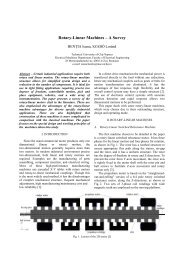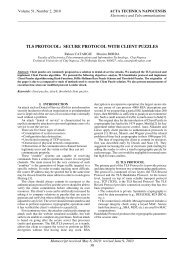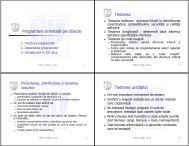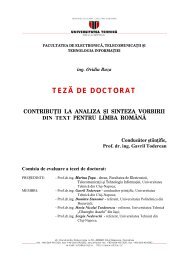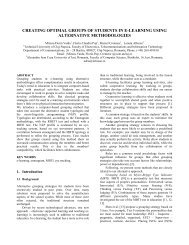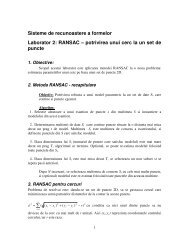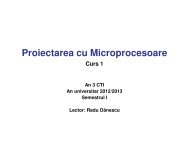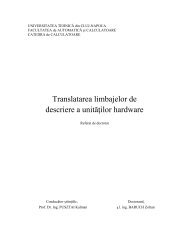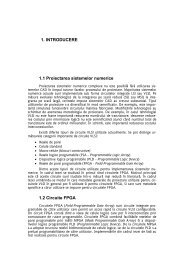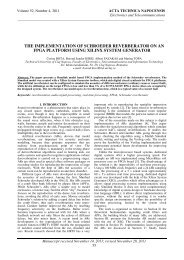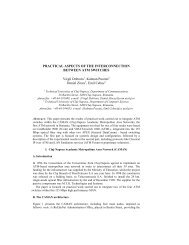LTE Emulator
LTE Emulator
LTE Emulator
You also want an ePaper? Increase the reach of your titles
YUMPU automatically turns print PDFs into web optimized ePapers that Google loves.
TUCN – Data Transmission Laboratory<br />
Finally, two tables are stored for the representation of the error distribution, namely: the<br />
quantized values of the distances between two consecutive errors and the cumulated probability<br />
density function (cdf function), computed based on the pdf function. The cdf function can be<br />
used more easily for the generation of random variables distributed according a given pdf<br />
function.<br />
The generation of the error-sequences also requires the distribution of the number of errors<br />
on a TTI time interval. This distribution should be considered together with the number of<br />
transmitted bits in such an interval. At the output of the simulated transmission chain, besides the<br />
random variable describing the distances between consecutive errors, a bi-dimensional random<br />
variable which jointly describes the distribution of the numbers of bit errors/TTI and the<br />
distribution of the numbers of bits/TTI is also provided. These distributions can be described by<br />
the matrix presented in fig. 5.7. The indexing in the matrix is given by number of bit errors/TTI<br />
(on rows) and by the number of bits/TTI (on columns), and the positions inside the matrix give<br />
the number of occurrences of a certain combination (pairs of counters of numbers of errors/TTI<br />
and bits/TTI).<br />
The matrix structure presented in figure 5.7 is not worth to be used as such to generate the<br />
two combined random variable, due to two reasons: a lot of positions of the matrix are empty<br />
(some pairs no. errors/TTI, bits/TTI have null occurrence probabilities); the generation of bidimensional<br />
random variables is more complicated and requires more processing time.<br />
For an easier generation of the above mentioned random variables, the matrix of fig. 5.7. is<br />
transformed into 3 tables, after the suppression of the zero-value positions. One table contains<br />
the no. of bit errors/TTI, the second table contains the no. bits/TTI, and the third table contains<br />
the numbers of the considered pairs. For a certain position in the matrix, the same position is<br />
used in each table to store the three mentioned values, as shown in figure 5.8., which illustrates<br />
the transformation of the matrix presented in fig. 5.7.<br />
To further decrease the numbers of positions in the three tables, a distance dt between two<br />
consecutive positions is defined according to relation (9).<br />
28<br />
no. errors/TTI<br />
a<br />
b<br />
c<br />
d<br />
e<br />
f<br />
g<br />
h<br />
bits/TTI<br />
i j k l m<br />
count j-a count l-a<br />
count i-b<br />
count m-c<br />
count i-d count k-d<br />
count j-e count k-e count l-e count m-e<br />
count i-g count l-g<br />
count j-h<br />
Fig. 5.7. Matrix structure which describes the bi-dimensional random variable no. errors/TTI<br />
and no. bits/TTI.<br />
i i i j j j k k l l l m m<br />
b d g a e h d e a e g c e<br />
cnti-b cnti-d cnti-g cntj-a cntj-e cntj-h cntk-d cntk-e cntl-a cntl-e cntl-g cntm-c cntm-e<br />
Fig. 5.8. Representation of the distribution of the bi-dimensional random variable<br />
no. errors/TTI - no. bits/TTI using a set of three tables.<br />
bits/TTI<br />
bit errors<br />
/TTI<br />
d t _ i = bit _ eri<br />
− bit _ eri<br />
−1<br />
+ biti<br />
− biti−1<br />
(9)<br />
where i is a given position in the tables, bit_eri represents the number of bit errors on position i,<br />
and biti represents the number of bits on position i.



